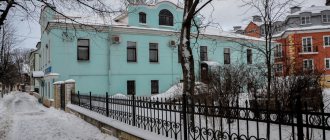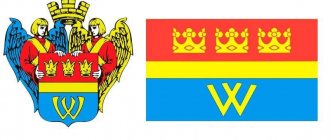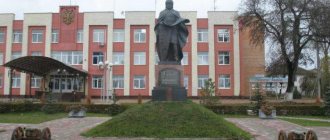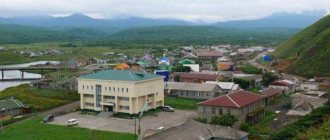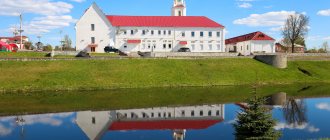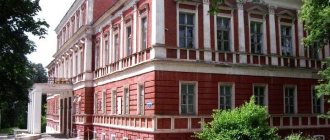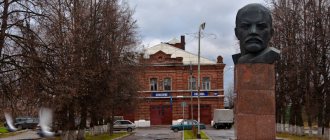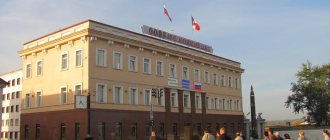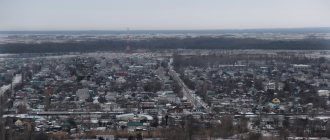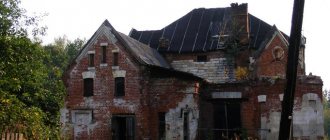History of the city of Gatchina
Historical documents from 1550 indicate that on the site of the modern city there was a settlement called Khotchino. The name comes from one version, which says that on this territory there was a cult place of the pagan goddess Khochena - the goddess of desire. In the middle of the 17th century, the blank letter “X” was replaced by the letter “G”.
According to another version, the name “Gatchina” comes from the words “gat” (a road built through a marshy place) and “khatsha” (an area where the forest was burned for arable land). For several centuries, Russia and Sweden laid claim to these lands.
In 1617, a treaty (Stolbovo Peace Treaty) was signed in the village of Stolbovo between the Russian Tsar Mikhail Fedorovich Romanov (the first Tsar of the Romanov dynasty) and the Swedish King Gustav II, and the territory became part of the Kingdom of Sweden.
85 years later, during the Northern War for the possession of the Baltic lands, Gatchina began to belong to the Russian Empire. In 1765, the territory of Gatchina was donated by Catherine II to Count G. Orlov.
After his death, his estate and the surrounding territory began to belong to the son of Peter III and the future Russian Emperor, Grand Duke Pavel Petrovich, who in 1796 awarded Gatchina the status of a city.
After some time, the city officially became the center of the Gatchina district. After the death of Paul I from 1801 to 1917. The owners of the territory of Gatchina were the wife of the emperor Maria Feodorovna (princess of the House of Württemberg), the Russian emperors Nicholas I, Alexander II, Alexander III.
During this period, the St. Petersburg-Gatchina railway connection was established (1853), and 28 years later the first electric street lighting in Russia appeared.
In 1910, the first airfield was built from which the founder of aerobatics, Pyotr Nesterov, flew, who in 1914 used the first ram in the history of aviation in the vicinity of the city of Zhovkva (now the city of Nesterov).
The city of Gatchina was renamed several times: Trotsk, Krasnogvardeysk, Lindemanstadt (during the occupation by German troops). In 1944 its historical name was returned. The city of Gatchina (45 km from St. Petersburg) is a modern regional center occupying an area of more than 28 km².
Thanks to the cultural monuments preserved and restored after the Second World War, the settlement attracts tourists from many European countries. The most popular sites, which are inextricably linked with the history of Russia, are included in walking tours organized by the excursion bureau.
History of city renaming
During the revolution, the estate was transferred to the Gatchina Committee of the Petrograd Soviet. In 1918, the authorities opened the Palace and park for viewing. The city changed its name more than once. In 1923 it was named by Trotsky, in 1929 it was renamed Krasnogvardeysk. During World War II, Gatchina was occupied (1941), and the Dulag-154 concentration camp was created on the territory of the city. The Germans renamed the city in their own way, calling it Lindemannstadt, but when the city was liberated (1944), the city returned its historical name - Gatchina.
Gatchina Palace
On Krasnoarmeysky Prospekt is the main attraction of the city of Gatchina, Leningrad Region - the Imperial Palace.
In 1765, Catherine II donated the lands of Gatchina to her close general-feldzeichmeister (the rank of chief artillery chief) Count Grigory Orlov in gratitude for his faithful service. A year later, construction of the complex began on the shore of the lake. Several dozen faceted towers and a unique 120-meter-long underground tunnel to the Silver Lake gave the palace the appearance of an English castle from the Middle Ages. After Orlov's death, in 1883, the complex became the residence of Emperor Paul I.
On his instructions, the Italian architect Vincenzo Brenna is rebuilding the building. In front of the palace, according to the Italian's plan, a canal is dug through which four bridges with cast-iron gratings are erected.
In 1845, the building was rebuilt again under Emperor Nicholas I.
An imperial church was built. At the same time, a new grand staircase was erected in the main central building for noble guests and members of the imperial family. Under Alexander III, the palace complex was electrified and telephone communications were installed.
Since 1918, the Gatchina Palace has been converted into a museum. It contained exhibits of palace decoration and life of the 19th century. During the Second World War the palace was partially destroyed.
Since 1950, the palace building has housed the Naval School, and after some time - the Electronstandart Research Institute.
Since 1960, restoration work began to restore the former interior of the premises. They continued for 15 years. Now tourists can see the completely restored marble dining room, the ceremonial bedchambers of the monarch and his family members, the underground tunnel and many other rooms of the imperial palace.
Restoration work
The war caused significant damage to the city and palace buildings. The park was cut down and restored in the post-war period. The Grand Palace, a landmark of Gatchina in the Leningrad region, was destroyed. Its restoration began only in 1976. Not all of the Grand Palace's interiors have been restored, but many were opened to the public as early as 1985.
Among them are state rooms such as the White Hall and the Marble Dining Room. The rooms illustrate the lives of Tsars Paul I, Alexander III and their families. The building is so large that restoration work continues to this day.
Terrace-pier
The Gatchina palace complex is located surrounded by a palace park, in which one of the main structures is the Big Terrace on the Long Island (the conventional name for a group of islands connected by bridges).
The court architect Vincenzo Brenna began its construction in 1772. The terrace was then used as a pier for the Gatchina flotilla. The structure was a multi-ton platform 52 meters long along the shore of Silver Lake. During the Second World War, the pier was heavily damaged.
The terrace railing, which was decorated with marble vases and sculptures of art goddesses, was destroyed.
Now, despite the absence of these decoration elements, the pier attracts tourists as a vacation spot on the territory of the Gatchina State Nature Reserve.
Unusual buildings in Gatchina
Walking along the streets of Gatchina, one cannot help but pay attention to interesting and unusual buildings. Of course, this is the main and first building of the city, the Grand Palace, but it was already mentioned in the article. It is worth looking at no less interesting and attention-grabbing objects.
The building of the Orphan Institute appeared after the death of Paul I. His wife, Empress Maria Feodorovna, took up charitable activities. In 1803, on the site of the former Animal Farm, she created an educational institution, which accepted children over 7 years old. After graduating from this educational institution, young people could go to study in St. Petersburg or get a job as governesses. The building of the Orphan Institute, which is one of the city’s landmarks, is not empty, but continues to perform the educational function of an educational institution. It now houses a boarding school.
A small house made in the Empire style looks unusual. It is located on the northern side of the palace park. This is Rozhdestvensky's mansion. Now it hosts ceremonial marriage registrations.
A two-story wooden house, entirely built of logs, looks unusual. It is located in the very center of the city and is used for its intended purpose, people live in it. Walking along the streets of the city, you can get to know its history better and become a part of Gatchina.
Priory Castle. Reviews from tourists
Not far from the imperial castle is the Priory Castle, surrounded by the trees of an ancient park. The peculiarity of this building is that it was built using a special technology. The building material is compressed earthen soil mixed with lime mortar (earthen).
After the revolution (1789-1799), the French prince Condé, who had lost his rights to the property of his lands, turned to Paul I for help, and the Russian emperor granted political asylum to Condé and members of his royal family.
In 1799, in Gatchina, on the shores of the Black Lake, a small monastery was erected under the leadership and design of the architect N. Lvov (Priory Castle). It was the residence of the prince and for 10 years was considered the property of the Order of Malta created in Russia.
After the death of the emperor, the castle was transferred to state use. At various times it was used as barracks, a hospital and other institutions. During the Second World War the building was almost undamaged.
After the end of hostilities, 35 years later, restoration work began to restore the previous interior. Now it is used as a branch of the historical museum.
Visitors to the city love this small castle. You can come by car and use the “yards” to get to the building. Guests note that a ticket to visit is inexpensive, it costs 180 rubles. This price also includes an audio guide. Tourists also note some disadvantages: an uncomfortable toilet and lack of a cafe.
Museum-reserve
The area of one of the attractions of Gatchina, the museum-reserve, is 146 hectares. It was here that the improvement of the estate began. The Italian architect Antonio Rinaldi was invited to build the Grand Palace. The elegant, neoclassical Gatchina Castle belongs to the most beautiful palaces in St. Petersburg. An observant visitor to the museum-reserve will definitely notice that the facades of the palace change color depending on the sunlight. In the sun they are golden and bright, on cloudy days of autumn they have a cold steel tint.
Together with park designer Vincent Brenna, the first landscape park in Russia was created, surrounding the castle, and laid out according to English canons. For 20 years, from 1770 to 1790, the famous architect and landscape architect created numerous parks and gardens that resemble a fairyland. The beautiful nature of this region is additionally decorated with luxurious palaces, parks, pavilions, lakes, and bridges. The pride of the park and the attractions of Gatchina (photo above) are unique pavilions, such as the “Temple of Venus” on the Island of Love and the interior of the “Birch House”.
Cathedral of the Intercession of the Blessed Virgin Mary. Tourists' opinions
What interesting attractions are there in the city of Gatchina? In the historical part of the city on the street. “Red” is a temple building that attracts tourists with its grandeur - the Cathedral of the Intercession of the Blessed Virgin Mary.
The construction of the temple, which is located on the territory of the Pyatigorsk women’s monastery (the name is derived from the nearby “Fifth Mountain” estate), dates back to 1885. The cathedral was erected at the expense of the Gatchina merchant Kuzma Karpov according to the design of the chief architect of Gatchina L. Kharlamov.
The church, in the construction of which the monastery nuns took part, was built in a purely Russian style, and in 1914 it was consecrated in the name of the Intercession of the Most Holy Theotokos. In those days, the cathedral was considered the largest religious building on the territory of the St. Petersburg province.
In 1930, the convent was closed, and the cathedral building was used as city warehouses. In 1990, the church became the property of the Gatchina diocese; after restoration work, daily liturgies have been held here since 1991.
Tourists who have been here advise everyone to visit this place. As guests of the city say, the territory of the cathedral, as well as inside it, is very beautiful. Many who visited the temple found peace and tranquility after visiting.
Museums of Gatchina
If you find yourself in Gatchina in winter, attractions in the city are also available at this time of year. This is the opinion of many of the tourists who have visited the city. You can stroll along snow-covered alleys in park areas, walk through the halls of the Great Gatchina Palace or visit the city’s museums.
The Museum of the History of the First Military Airfield of Russia offers very interesting exhibitions. Not many people know how and where Russian aviation was born. It will be interesting to know that such world-famous pilots as Chkalov and Nesterov flew in the skies over Gatchina. You can look into the Museum of Naval Glory, a branch of the St. Petersburg similar museum, which was founded in 1709 by Peter the Great.
The local history museum is located in the Priory Palace. This building was used by the Romanov family for various purposes. These were apartments for the courtiers, then for a long time this palace served as a place for exhibitions. In Soviet times it was a recreation center, a hospital and a House of Pioneers. Currently, it houses a museum. Opening hours: from 9 to 17.
Submarine monument
Tourists, heading to the Gatchina Palace from the Baltic Station, pay attention to an unusual structure - a monument to a submarine, which was opened in 2006.
In 1873, Polish inventor Stefan Drzewiecki was invited to Russia. In 1876, he created the first model of a submarine, which was tested two years later in Odessa.
The second example was provided to Tsarevich Alexander (future Russian Emperor Alexander III) in 1880 on Silver Lake in Gatchina.
The submarine sailed several times under the boat on which the emperor was. Then the inventor placed a mine under the raft that had been prepared by this time, surfaced not far from the imperial pier and blew it up.
Gatchina is the site of testing the second model of the boat, which became the world's first serial warship capable of diving and operating underwater (submarine). After some time, the emperor gave instructions for the construction of 50 submarines. They successfully carried out combat missions in Sevastopol and Kronstadt. The monument is an exact copy of the second model of Drzewiecki's invention, made of stainless steel and mounted on a pedestal.
What travelers noted
Those who have visited Gatchina believe that the best time to stay in the city will be spring and autumn, when the Great Gatchina Palace and the park ensemble around it - the main attractions of Gatchina - appear in all their glory. The park is located in the center of the historical city, so you can easily get to it and also see the center of Gatchina. Access to the park is currently free.
In the summer, at the boat station you can take a boat or catamaran and visit the Island of Love in the romantic Venus Pavilion, and not far from it see the Birch House. The sprawling parks: Palace, Priory and Sylvia are beautiful during the golden autumn.
The residence of the Tsars today hosts exhibitions of paintings by artists from Western Europe and Russia. The majestic and valuable collection of porcelain is also worth seeing. Another attraction of the Grand Palace is the tunnel to the lake.
How to get to Gatchina?
Where is the city of Gatchina? The settlement is located 45 km southwest of St. Petersburg near the Izhora River. How to get to the city?
Tourists can get to Gatchina by several routes:
- You can use bus route No. Kt8, Kt8A from Moskovskaya Square (Moskovskaya metro station) travel time is 40-45 minutes.
- By minibus (metro station "Prospect Veterans") No. K 631. Travel time - 60 minutes.
- By train from the Baltic station.
- The most convenient way to get there by private car is along the Kievskoye or Krasnoselskoye highways.
What to see in Gatchina in 1 day
You can’t get around all the famous places in Gatchina in a couple of days. The bulk of historical monuments of architecture and art are concentrated in the Palace Park, which dates back to the 18th century.
Grand Palace
The brainchild of the architect Antonio Rinaldi, built for Count Orlov in 1781, it was rebuilt many times by new owners. The main symbol of Gatchina, which is worth a visit, was the favorite vacation spot of the imperial family. Resembling an old medieval castle and made in the spirit of classicism, the Grand Palace took 15 years to build from expensive Pudost stone. Luxurious apartments and 18th-century halls are open to the public. For those who want to plunge into the depths of history in the literal sense of the word, they will show you the underground passage leading from the palace bedrooms to the Silver Lake.
Address: Krasnoarmeysky Prospekt, 1.
Opening hours: all days except Monday, from 11.00 to 19.00.
Get directions
You can get there by buses 3, 7 to the Gatchina Palace stop.
Palace Park
The park, with an area of 143 hectares, shines with the richness of nature, which is famous among travelers, while preserving all the luxury intended for the imperial family. The layout was conceived as a tiered panorama, so there are many magnificent viewing platforms pointing towards the palace and pavilions. It will take a lot of time to get acquainted with the labyrinths, the Dutch Garden, the Botanical Garden, and the islands.
A quarter of the area of the Palace Park is occupied by bodies of water: lakes, Serebryanoye and Beloe, rivers, and artificial ponds. Therefore, a walk through the Palace Park can be done by boat.
Location: Krasnoarmeysky Avenue, 1.
Opening hours: daily, 6.00-22.00.
You can get there by bus 3, 28 to the “Palace” stop.
Get directions
Pavlovsk Cathedral
The five-domed pseudo-Russian style temple was built in the mid-19th century. The cathedral attracts believers with its rich interior decoration and carefully preserved relics: the miraculous icon of the healer Panteleimon and the relics of Mary of Gatchina.
Address: st. Sobornaya, 26.
Opening hours: daily, 8.30-20.00.
You can get there by buses 3, 7, stop “Sobornaya”.
Get directions
Priory Palace
An unusual palace-castle, worth visiting, is located on the shores of the Black Lake. Built at the end of the 18th century for the Prince of Condé, who was hiding from the massacre of the revolutionaries. Russian Emperor Paul I did not refuse to help his “colleague” and quickly built a personal landholding for him - a small copy of the Maltese priory. The ascetic palace is stylized as a Catholic cathedral, decorated with a stone tower and protected by a blind fence. There is a tunnel underneath that leads to the Grand Palace.
Address: st. Chkalova, 22.
Opening hours: Wednesday-Sunday, from 11:00 to 19:00.
Travel by bus 431 to the “Warshavsky Station” stop.
Get directions
Monument to Paul I
The monument to Paul I is a symbol of the city, a tribute to the memory of its founder. The monument was erected in the summer of 1851. The royal family of Nicholas I took part in its magnificent opening. It is surprising that it was not demolished during the revolutionary period, like some famous monuments. The townspeople always treated him with respect. Only once did they make one free joke: they dressed the statue in a naval vest in honor of the celebration of Navy Day.
Location: Krasnoarmeysky Avenue, 1.
You can see the famous monument around the clock.
You can get there by buses 3, 7 to the Gatchina Palace stop.
Get directions
Monument-model of the submarine S. Dzhevetsky
The first presentation of the Russian submarine took place in Gatchina in the summer of 1881 in front of Tsar Alexander III, who watched its launch on Lake Serebryany. The engineer’s efforts were successful: the submarine surfaced not far from the royal ship, and the captain, who was also the inventor, presented the empress with a bouquet of wild flowers. Now a full-size model of that submarine is one of the main attractions of Gatchina.
Location: Cuirassier Boulevard.
You can see the miracle of engineering from the century before last around the clock.
Travel by buses 3, 7, 525 to the Gatchina Palace stop.
Get directions
Intercession Cathedral
The snow-white temple with golden stars on sky-blue domes is made in the Old Russian style and was consecrated before the outbreak of the First World War. For the splendor of the decoration of the halls, immersed in sunlight, ancient icons and caskets with particles of the relics of saints, parishioners love to visit the cathedral. Tourists who have visited the temple once want to return here again to listen to festive services and professional choir singing.
Address: st. Red, 1.
Opening hours: daily, 7.00-19.00.
Travel by bus 21, 431 to the Music School stop.
Get directions
St. Nicholas Lutheran Church
The austere classical stone church, built at the beginning of the 19th century, is designed for 220 parishioners. An elongated rectangular building, decorated with a dome, portico, columns, lined with limestone, is included in the register of major architectural monuments. The Lutheran Church is active, there are Sunday and confirmation schools, beautiful baptismal rites are held, and a children's church choir sings.
Address: 25 October Avenue, 39.
Opening hours: Tuesday, Thursday, Sunday, 9.00-14.00.
Travel by bus 37 to the Kirkha stop.
Get directions
Birch house and portal “Mask”
The portal “Mask” earned its name thanks to the secrets hidden behind its walls. Behind the simple façade of the Birch House lies an unexpectedly luxurious pavilion. These are interesting places intended for the nobility who walked in the park. The ceiling depicts a father and son flying in the clouds. In the corners of the building there are painted women with zodiac signs. In a secluded niche there is a gazebo with walls of mirrors and seemingly living climbing roses.
Address: Krasnoarmeysky prospect, 1.
Opening hours: every day, 11.00-19.00.
You can get there by buses 3, 7 to the Gatchina Palace stop.
Get directions
Marienburg and Gatchina geysers
The suburb of Gatchina preserves wooden houses of the 18th century, where servants of the imperial court lived. Narrow ancient streets will show the past. On the edge of Marienburg there are six fountains that do not freeze in winter. Locals call this natural attraction geysers, although the water in them is cold. In winter, fabulous figures of transparent ice form around the fountains.
Address: Korpikovo, 1.
You can see popular places around the clock.
You can get there by bus 525 to the Korpikovo stop.
Get directions
